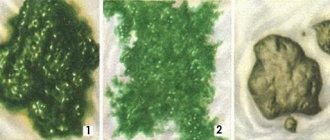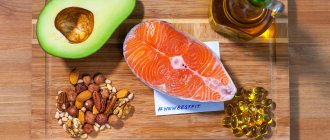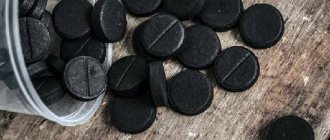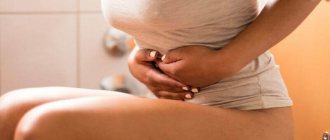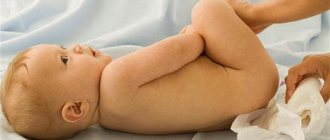The article was checked by gastroenterologist and endoscopist Kondrashova E.A. , is for general informational purposes only and does not replace specialist advice. For recommendations on diagnosis and treatment, consultation with a doctor is necessary.
At the Yauza Clinical Hospital, experienced gastroenterologists will conduct an examination, identify the causes and prescribe treatment for any stool disorders (semi-liquid, mushy, unformed stool). The clinic has all the capabilities to diagnose diseases of the digestive tract (endoscopy of the stomach, duodenum, colon, rectum with biopsy, special laboratory tests, examination of the gastrointestinal tract using computed tomography and ultrasound).
Normally, feces consists of 30% water and 70% dry residue - processed food bolus, dead cells of the intestinal wall and epithelium. If there is a violation of the processing and absorption of food, its evacuation, or an imbalance of the microflora, the nature of the stool changes. The cause of the appearance of semi-liquid, mushy feces can be various diseases of the gastrointestinal tract (GIT), as well as diseases not directly related to intestinal damage. At the Clinical Hospital on Yauza, you can undergo an examination of the whole body as a whole and determine the true causes of loose stools.
Causes of mushy stool
Early childhood
In children of the first year of life, soft, unformed yellow stools are a variant of the norm, which is due to monotonous feeding with breast milk or formula, and restructuring of the digestive system due to increasing food loads. In infants up to 3-4 months, mushy feces are excreted after each feeding, then the feces become more formed, stools are reduced to 4-5, and then less times per day.
Nutritional Features
Atypical mushy stool is observed when the day before you have consumed fatty foods or desserts with a lot of cream. Remains of undigested fat move through the intestines, softening the stool, acting as a natural laxative. The next day after a heavy feast, defecation is observed 2-3 times a day, the stools are soft and “greasy” in appearance. At the same time, general health, as a rule, is not disturbed.
Abundant, mushy feces periodically occur in people who follow a strict plant-based diet with limited bread and cereals. Vegetables contain a large amount of fiber, so they help increase the volume of stool and change its consistency. Bowel movements usually occur once a day. If loose stools, nausea, or abdominal pain appear as part of your usual diet, you should visit a doctor.
Emotional factors
The normal functioning of the digestive organs is inextricably linked with the stable functioning of the central and peripheral nervous systems, therefore, during stress or other psychogenic shocks, mushy feces are often formed. The symptom can be caused by various reasons: an upcoming interview at work, delivery of an important project, a quarrel with a loved one. A change in stool is preceded by rumbling and discomfort in the abdomen.
Poop, which resembles a mush in appearance, is observed in students or school graduates before exams. In addition to defecation disorders, cramping abdominal pain, a painful feeling in the pit of the stomach, and nausea are typical. Liquid, pasty stool occurs once, all symptoms disappear when the stress factor is eliminated. The development of long-term dyspepsia against the background of stress often indicates organic causes and requires examination by a specialist.
Irritable bowel syndrome
In this condition, patients are concerned about various disturbances in the frequency and consistency of stool, but the most common variant is one with a predominance of diarrhea. Pasty feces can be either completely liquid or in the form of soft “flakes” and lumps. The act of defecation is accompanied by discomfort in the abdomen, and sometimes there is pain in the anal area. The appearance of symptoms is provoked by errors in diet, psycho-emotional stress, and intercurrent illnesses.
Pasty bowel movements in the morning, 30-40 minutes after waking up, are typical for IBS. Stool is preceded by intestinal spasms, stomach rumbling, and a painful urge to defecate. After visiting the toilet, all symptoms disappear, and during the day a person can feel absolutely healthy. If pasty stool is passed for a long time and is not associated with the time of day, this indicates the addition of a chronic gastrointestinal pathology.
Food allergies
Allergens that penetrate the digestive tract irritate the intestinal mucosa and increase the secretion of water into the intestinal lumen. In this case, the feces soften and are released in the form of a heterogeneous paste, sometimes with a foul odor. Defecation occurs 2-3 hours after eating the allergen product and is accompanied by heaviness in the stomach and severe nausea. Sometimes food allergies cause massive diarrhea with loose, watery stool, which requires medical attention.
Dysbacteriosis
Disruption of the normal microflora of the large intestine with colonization by pathogenic organisms is caused by various reasons: all acute infections of any location, severe somatic diseases. With dysbiosis in the intestine, the processes of bacterial putrefaction and decomposition predominate, which is clinically manifested by mushy, foul-smelling stool, on the surface of which a greenish-gray coating can be seen.
The frequency of defecation ranges from 4-5 times per day; a meager amount of unformed feces is released at a time. The passage of bowel movements is preceded by intense cramping pain in the lower abdomen, rumbling, and tenesmus. The condition improves by following a strict diet (slimy porridges and soups, stewed vegetables). When adding hard-to-digest foods to the diet, mushy stools become more frequent up to 10 times a day, and pain in the abdomen intensifies.
Hypovitaminosis
The most typical appearance of mushy feces is due to a deficiency of vitamin PP (nicotinic acid). This symptom mainly occurs in people who follow strict diets with limited animal foods and grains; with a normal, nutritious diet, vitamin deficiency almost never occurs. Patients note increased frequency of stools and impaired digestion of food, as a result of which food residues and mucus are visible in liquid stool.
The symptom is also observed with a lack of other vitamins, most often in early spring. The stool passes in the form of a pulp periodically, the frequency of bowel movements remains normal or increases slightly. In addition to changes in the consistency of stool, abdominal cramps, nausea after eating, and flatulence are also disturbing. Severe hypovitaminosis C is characterized by copious watery stools with mucus, in which streaks of blood are sometimes visible. The symptom is accompanied by bleeding from the gums and nose.
Intestinal infection
Bacterial and viral infections are common causes of mushy stool in people of any age. Most often, dyspeptic disorders occur within 8-12 hours after consuming a suspicious product. A person experiences severe nausea and vomiting, the urge to defecate, which ends in the release of watery, heterogeneous feces with pieces of undigested food. The stool may change color to greenish-yellow.
In case of poisoning with specific pathogens (salmonella, shigella), a prodromal period is observed during the first 24 hours; stools are more often formed, but have a softer consistency. On the second day, intense pain develops in the navel area or in the left abdomen, which is accompanied by frequent bowel movements. The stool becomes liquid, acquires a foul odor and a greenish tint. The main infectious causes of mushy stool:
- Bacterial diseases
: salmonellosis, escherichiosis, foodborne illness, dysentery. - Viral infections
: rotavirus gastroenteritis, enterovirus infection. - Protozoal infestations
: amebiasis, giardiasis.
Gastritis
Feces that look like mush are more typical of hypoacid gastritis, but can also form with increased acidity of gastric juice. Pasty feces are often caused by heavy meals, diet disorders, and stress. Unformed stool also indicates an exacerbation of a chronic process. In this case, it is combined with dull arching pain in the epigastric region, nausea and rotten belching.
Hyperacid gastritis is characterized by frequent bowel movements with the release of small amounts of soft or liquid feces. Defecation is preceded by sharp spasms in the epigastrium and umbilical region, vomiting. The symptom is not constant. Its development is facilitated by skipping doses of hypoacid medications and abuse of heavy fatty foods. The passage of unformed black feces is an alarming symptom that requires emergency care.
Pancreatitis
In chronic pancreatitis, exocrine pancreatic insufficiency occurs. Digestive disorders and malabsorption syndrome are noted. Stool frequency is on average 1-2 times a day, the stool is soft in consistency and gray in color. The stool looks “oily” and leaves marks on the walls of the toilet. With exacerbation of pancreatic inflammation, the number of bowel movements increases, feces become foul-smelling and profuse.
Diseases of the hepatobiliary system
If there is insufficient amount of bile in the duodenum, fats are not broken down and are excreted in the form of large drops with feces. Acute cholecystitis is characterized by lightening and softening of stool: during defecation, a grayish-white pulp with a pungent odor is released. In a chronic process, the stool is of normal color, resembles soft lumps or layers, but not liquid. Defecation disorder is accompanied by pain in the right hypochondrium, nausea, and bitterness in the mouth.
A similar clinical picture is determined with liver damage of various causes: viral and autoimmune hepatitis, fatty infiltration, hepatosis. In addition to pasty stools, patients complain of dull pain and heaviness in the right abdomen, constant nausea, and vomiting with bile. With viral hepatitis A and E, normalization of stool consistency occurs after 2-3 weeks, with hepatitis B - within several months.
Other gastrointestinal diseases
Loose stools occur with any pathology of the digestive system, but more often with damage to the intestinal tract. Depending on the activity of the process, mushy feces are passed with each bowel movement or only in case of violations of the therapeutic diet. Before bowel movement, pain and discomfort increase. Defecation can slightly improve the patient's condition. Intestinal causes most often lead to stool instability, such as:
- Inflammation of the intestine
: Crohn's disease, ulcerative colitis, Whipple's disease. - Colon lesions
: pseudomembranous colitis, lymphocytic colitis, diffuse polyposis.
Congenital enzymopathies
Symptoms in the form of mushy stools are most typical of lactase deficiency. In the complete absence of the enzyme, pathological signs appear from 2-3 days of a child’s life; milder forms are missed in childhood and manifest in adults. Patients note the appearance of loose stools a few hours after taking dairy products, while the duration of dyspepsia rarely exceeds 2 days.
The presence of such signs in adults is not considered a serious disorder: according to statistics, about 40-50% of the population do not digest milk properly. Eliminating irritating foods from the diet helps normalize the functioning of the gastrointestinal tract. If dyspeptic disorders persist for a long time, despite a lactose-free diet, consultation with a specialist is indicated.
Celiac disease
With gluten intolerance, mushy stools are constantly observed, feces have a gray color and a specific fetid odor. Cereals containing this protein form an important part of the daily diet, so the disease occurs with severe clinical symptoms. Patients with celiac disease experience severe bloating and rumbling in the intestines. The feces become foamy, profuse, and contain particles of poorly digested food.
Endocrine disorders
Increased frequency and softening of stools occurs with thyrotoxicosis, since an increase in the level of thyroid hormones accelerates intestinal peristalsis. A person complains of periodic painful spasms and rumbling in the stomach. A pathognomonic sign is normal or increased appetite, which is accompanied by sudden weight loss. The formation of pasty stools is also caused by other endocrine causes: diabetes mellitus, Addison's disease.
Complications of pharmacotherapy
The consistency of stool always changes after completing a course of antibiotic treatment. Antimicrobial drugs disrupt the normal microflora of the colon, causing dysbiosis and bacterial overgrowth syndrome. Unformed, mushy stools pass, acquiring a grayish-green tint due to putrefactive processes. The symptom develops with excessive consumption of lipid-lowering drugs, choleretic drugs, and laxatives.
Rare causes
- Iatrogenic conditions
: complications after gastrectomy, dumping syndrome. - Hormonally active tumors
: VIPoma, gastrinoma, medullary thyroid carcinoma. - Vascular diseases
: small intestinal ischemia, hemorrhagic vasculitis. - Acute surgical diseases
: appendicitis, mesadenitis, colon diverticulitis. - Malignant tumors
. - Intoxication of the body
: uremia, liver failure, alcohol or drug poisoning.
Benefits of Duphalac®
Duphalac® has a dual effect: it gently and comfortably cleanses the intestines, providing a laxative effect, and due to its prebiotic effect, the drug allows you to restore the balance of intestinal microflora and has a long-term effect in normalizing stool6,10.
Duphalac® has a favorable safety profile and is suitable for people of any age, as well as children from the first days of life, pregnant and lactating women2,10.
Duphalac® is the optimal remedy for chronic constipation and irregular bowel movements, since when it is taken, the intestines do not stop working on their own, and it can be used for as long as necessary9,10.
RUS2132194 from 07/21/2020
Co-author of articles, editor - Shimbaretsky Georgy Alekseevich.
Diagnostics
A gastroenterologist examines patients with mushy stools. First, the doctor takes a medical history, performs a physical examination, and checks for symptoms of peritoneal irritation to rule out an “acute abdomen.” Then a set of instrumental and laboratory studies of the digestive tract is prescribed to clarify the cause of dyspeptic disorders. The most informative diagnostic methods:
- Sonography
. During an ultrasound of the intestine, the general anatomical features of the intestine are studied, dilated loops or thickening of the intestinal wall are identified, which serves as a sign of specific inflammatory changes. Targeted ultrasound of the liver helps to identify structural heterogeneity, neoplasms or abscesses. - Endoscopy
. A colonoscopy with examination of the entire colon is informative, which allows you to identify common causes of pasty bowel movements in older people - Crohn's disease, diverticulosis, neoplasms. If gastritis or duodenitis is suspected, an endoscopy with a biopsy is performed, a test for cell metaplasia by staining with methylene blue. - Radiography
. Irrigoscopy with double contrast effectively detects ulcerative-destructive disorders, intestinal abnormalities or tumor formations. During the X-ray examination of the passage of barium through the intestines, peristalsis is checked, motor dyskinesias are excluded, and inflammatory processes in the upper gastrointestinal tract are diagnosed. - Coprogram
. Pasty stool in an adult is visually assessed using the Bristol scale. Microscopic analysis is intended to determine signs of malabsorption and inflammation. Be sure to do an analysis for intestinal dysbiosis and culture of stool on nutrient media to confirm the infectious cause of defecation disorders. - Blood tests
. Liver tests and measurement of the concentration of bilirubin fractions are carried out to exclude concomitant damage to the biliary tract. With liver disease, the protein content in the blood is reduced. An immunological blood test is necessary to identify antibodies to intestinal pathogens. The hormonal profile must be examined. - Additional methods
. To confirm helicobacteriosis, they look for fecal antigen or perform a rapid urease test. In case of doubtful liver tests, duodenal intubation with bacterial culture of the obtained bile and RCP are performed. To exclude abdominal ischemia syndrome, Doppler ultrasound of the abdominal vessels is recommended.
Signs and symptoms
A sharp urge to go to the toilet is one of the signs of steatorrhea
The stool is usually loose, copious and quite frequent. However, steatorrhea may well be accompanied by constipation. Any form of oily bowel movement is characterized by the formation of a poorly washed off stain with a greasy sheen in the toilet bowl. The color of the stool can be normal, light or grayish.
Patients suffer from dizziness, bloating and rumbling in the intestines that occur in the upper abdomen, constant drying of the mucous membranes of the mouth and nose, lethargy, and decreased performance. They suffer from a dry cough, frequent frequent loose bowel movements, and pain that occurs at the ends of the long bones. They are worried about pain in the spine and joints.
People burdened with steatorrhea rapidly lose weight and become exhausted.
In patients, the subcutaneous fat tissue is underdeveloped, the skin is dry, flaky, and often affected by polymorphic erythema. They have dry and pale lips, cracks in the corners of the mouth. The oral cavity shows signs of stomatitis, the tongue is brightly colored, sometimes with atrophied papillae, the gums are loose and bleeding.
Treatment
Help before diagnosis
Pasty stools that are not associated with a single overeating or stress factor are an indication for dieting. In the first 2-3 days, you need to relieve the gastrointestinal tract as much as possible, for which it is recommended to take semi-liquid food, all foods should be boiled. The diet includes dishes rich in pectin and potassium - baked apples, bananas, boiled turkey and chicken. Small meals, at least 4-6 times a day.
If mushy stools become even more liquid, it is important to ensure adequate water intake - adults, about 2-2.5 liters of fluid per day, so as not to provoke dehydration of the body. The combination of mushy bowel movements with intense pain in the abdomen, increased body temperature, and vomiting indicates the presence of a serious cause of bowel dysfunction. In such a situation, medical attention is required.
Conservative therapy
During therapy, caffeine-containing drinks and foods with artificial sweeteners are discontinued, and the intake of medications that affect gastrointestinal motility is limited. Drugs for the treatment of mushy stool are selected based on the cause of the disease. Specific antidiarrheal drugs are not indicated; pathogenetic and etiotropic therapy is used to eliminate symptoms. The treatment regimen includes:
- Enzymes
. The products are analogues of pancreatic enzymes, improve food digestion, and normalize the volume and consistency of stool. They are indicated not only for pancreatitis, but also for gastritis, hepatitis, accompanied by malabsorption. - Probiotics
. The drugs are beneficial lactobacilli that colonize the large intestine and eliminate the manifestations of dysbiosis. Probiotics are taken for a long time, until formed stool appears and other dyspeptic symptoms disappear. - Antispasmodics
. Pasty stools are often combined with pain in the abdominal cavity, which can be eliminated by medications with an antispasmodic mechanism of action. For severe pain, analgesics from the group of non-steroidal anti-inflammatory drugs are used. - Antibiotics
. Bacterial causes of loose stool require the use of local drugs that act primarily in the intestinal lumen (nitrofurans, some sulfonamides). For viral enteritis, etiotropic therapy is not carried out. - Sedative herbal medicines
. Herbal sedatives effectively relieve symptoms of IBS, normalize mood and indirectly affect the functioning of the digestive tract. For stress, therapy includes mild anxiolytics and antidepressants. - Rehydration solutions
. With frequent loose stools, it is important to ensure adequate replacement of lost fluid. In the absence of vomiting, oral saline solutions containing the optimal amount of electrolytes are given for drinking.
Complications caused by steatorrhea
The disease is accompanied by certain complications. In the intestine, malabsorption of nutrients occurs, resulting in:
- Protein deficiency (the process is associated with a lack of protein).
- Hypovitaminosis, provoked by a deficiency of vitamins (in particular, fat-soluble ones).
- Weight loss before the onset of cachexia, a disease accompanied by profound exhaustion and weakness of the body.
- Water-salt imbalance, expressed by an incessant feeling of thirst, swelling, dehydration (dry skin and mucous membranes), convulsive conditions (involuntary paroxysmal muscle contractions).
- Oxaluria - excessive excretion of oxalic acid salts and the presence of oxalates - insoluble stones that lead to blockage of the kidneys and urinary tract. During normal processes, such stones (essentially insoluble salts of oxalic acid and calcium) are not able to penetrate from the intestines into the bloodstream. Steatorrhea allows calcium to react with fats and leave the body, and oxalates to enter the blood in excess.
- Organ damage. The kidneys, heart, respiratory system, and brain suffer.
- Problems of a psychological nature. Sleep is disrupted, the quality of work drops, and communication becomes difficult.
Timely treatment with the right therapeutic approach helps to avoid such consequences.
Types of constipation
Constipation is classified according to the reasons for its development into the following types:
- Primary: functional constipation, including those developing against the background of IBS or weakened defecation reflex, as well as organic - structural and inflammatory changes in the intestine.
- Secondary: peptic ulcer, diseases of the endocrine system and nervous system, intoxication, systemic muscle damage, etc.
According to the mechanism of development and etiological characteristics, the following types of constipation are distinguished: +
- nutritional – explained by the specifics of the diet;
- neurogenic - associated with disruption of the nervous system;
- psychogenic - develops against the background of psycho-emotional factors, including the so-called false shame, inability to visit a public toilet, etc.;
- proctogenic - constipation due to diseases of the anorectal area, fissures, narrowing, inflammatory changes accompanied by pain;
- iatrogenic - associated with taking medications;
- toxic - formed against the background of human poisoning with lead, mercury vapor, etc.;
- constipation in the presence of mechanical obstacles in the form of tumors, narrowings, scar changes, benign formations such as polyps, etc.
According to the characteristics of the course in adults, acute and chronic constipation are distinguished. An acute condition may include stool retention for the first time recently (up to three months). There is no bowel movement for several days.
Chronic constipation has clear criteria. The doctor will make such a diagnosis if there are simultaneously two or more signs observed over the past 3 months:
- bowel movements less than three times a week;
- dense, dry, fragmented feces;
- the need to strain in 25% of cases;
- straining takes at least ¼ of the defecation process;
- need for manual assistance during defecation;
- feeling of incomplete bowel movement, foreign object in the rectum, pressure.
Chronic constipation may be accompanied by other symptoms.


